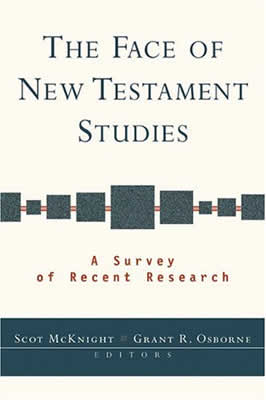NEW TESTAMENT The Face of New Testament Studies: A Survey of Recent Research edited by S. McKnight & G. Osborne (Leicester: Apollos, 2004). In 1999 Baker Academic and Apollos published a wide-ranging survey of recent research on the Old Testament called The Face of Old Testament Studies' Five years later, this companion volume is a similar “state of the art” review of the various sub-departments of New Testament studies, from textual criticism to social studies, from parables and Luke-Acts to Pauline theology. Twenty-two chapters written by acknowledged experts in their respective fields set out and evaluate the current thinking in their particular area. This is a useful work for several kinds of people. First, it is a useful book for anyone wanting to gain an overall view of the state of New Testament scholarship, whether they are students, scholars of another discipline (say, Old Testament studies or systematic theology), or specialists in only one area of New Testament wishing to understand contemporary developments in another specialised field. It would also be useful for ministers who left theological college some time ago should they wish to read up on how academic study has progressed in the intervening years, or indeed for any minister wanting to gain an appreciation of modern critical scholarship on a corpus of material they may be preaching on. For instance, Stanley Porter’s robust and provocative study on Greek grammar and syntax charts the rise of several new ways of analysing and understanding koine Greek (including verbal aspect theory, of which he is a major practitioner). This is very useful considering the impact such new methods are starting to have on biblical commentaries, although Porter’s scathing indictment of older methods of study and his thinly disguised disdain for those who do not adopt his own new paradigm in toto will not necessarily win adherents. Craig Blomberg’s chapter on John and Jesus is especially helpful here with his broad brush survey of the last 30 years of scholarly activity. Blomberg also gives an insightful warning about “a clear trend in one important wing of biblical studies internationally: the embracing of increasingly anti-Christian perspectives” (pages 216-217) and the sidelining and (deliberate?) neglect of first-class evangelical monographs and commentaries by the scholarly guild (page 218). Several articles make tantalising comments about the possible future direction of studies in their field. Walton on Acts, for instance, mentions the possibility of further studies (building on the work of Bruce Winter) of the standard rhetoric of 1st Century forensic proceedings and how this aids our understanding of Paul’s speeches in the latter part of Acts. Others also suggest ways in which their fields may develop in the next decade. An evangelical piety which fits the academic study of the text into a warm-hearted believing framework creeps occasionally into some articles, but is sadly absent in others. The contributors are not uniformly evangelical or conservative in viewpoint (James D. G. Dunn, for instance, contributes the chapter on the theology of Paul) but they do all have a well-known breadth of knowledge in their areas of expertise and have previously published material on them (Peter Bolt on Mark’s Gospel, Darrell L. Bock on Luke, and Grant R. Osborne on Revelation for instance) which makes this a fine, solid, and reliable reference work. This review was also published in Churchman 120/1 (2006). |
